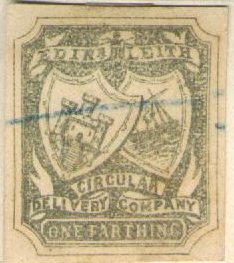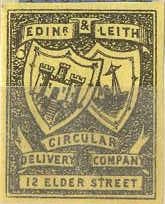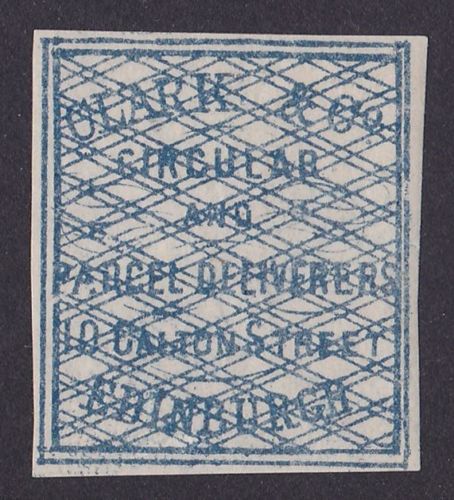 |
|||||
|
|||||
| Preview of Stamps Catalogue: VOLUME 1 |
 |
|||||
|
|||||
| Preview of Stamps Catalogue: VOLUME 1 |
Return To Catalogue - Great Britain - Great Britain Local issues part 1 (delivery companies)
Note: on my website many of the
pictures can not be seen! They are of course present in the catalogue;
contact me if you want to purchase it.
With thanks to David Stirling (Scotland) for his help with this page. He has put up a site to distinguish the forgeries of these stamps, see Cinderella site by David M. Stirling: http://www.geocities.com/david_m_stirling/Home.html.
More information about this area can be found in the following book: "Great Britain: The Stamps of the Circular Delivery Companies and their Forgeries", isued by the Cinderella Stamp Club, Handbook No 7, By C G Harman, London: The Cinderella Stamp Club and Frank Godden Ltd. 1990.
Other book: 'Farthing Delivery, a Right for Cheaper Postage' by Donald S. Patton, London, Lowe & Brydon (printers) Ltd.
These companies were established by James Nixon Brydone or his son Robert. They exist for nine cities of the United Kingdom. However, they were never put into use because the Post Office sued them. There are several forgeries of these stamps.
David Stirling writes:
This Company was one of the farthing circular delivery companies formed by Robert Brydon of Edinburgh, and emulating the system and pricing of the Glasgow Parcel Delivery Company which, for some twenty years previous, had been undertaking the same task at the same competitive prices. Although other writers have hailed this form of cheaper delivery as an innovation of Brydone's, such was not really the case. The stamps appeared in July, 1867, but there is no conclusive evidence that they were ever put into actual use. The stamps were lithographed in sheets of 130, 10 across by 13 down. The farthing value is the scarcest of the two stamps. They were manufactured by James Edward Nixon Brydone, Printer and Lithographer, of Edinburgh, the father of Robert Brydone. His printing establishment was at 12 Elder Street.


(Reduced sizes)
1 f (=1/4 p) orange-brown. 1/2 p blue (shades).
The farthing value is normally more heavily printed than the halfpenny stamp and many of the stamps, being smudged and badly printed, were destroyed. This accounts for its relative scarcity. No used or imperforate specimens, of either stamp, have been noted.
1/4 p blue (perforated or imperforate) 1/2 p lilac (perforated or imperforate 1/2 p grey (perforated or imperforate



Note the 'pencancels' on the above stamps.
1/4 p green 1/2 p red

One Farthing "LONDON" in the wrong color: red instead
of green.

I've been told that this is a genuinely used Metropolitan
Circular Delivery stamp. It has a red cancel.


Note that the "E" of "METROPOLITAN" has
partly disappeared in this 1 f red stamp, thus reading
"MF" instead of "ME". Also 1/2 p.


Liverpool; 1/4 p brown and 1/2 p lilac
David Stirling writes:
The stamps for this company appeared in February 1867 and were printed by James Edward Nixon Brydone. Two values exist, imperforated or pin-perforated, in sheets of 66 (11 horizontally and 6 vertically) on laid paper.


1/4 p black on white laid paper, pin-perforated, and variety
imperforated in between, reduced sizes
1 f (=1/4 p) black (intense black to grey black)
(imperforated or perforated)
1/2 p red
David Stirling writes:
The Edinburgh & Leith Circular Delivery
Company was the first of Robert Brydone's circular delivery
companies and, at first, shared premises with Edinburgh &
Leith Parcel Delivery Company, at 12 St Andrew Square. Despite
what may have been said by other writers, the idea of circular
delivery was not novel and, indeed, had been practised by the
Glasgow Parcels Delivery Company since 1846. Both Edinburgh
Companies had been formed towards the end of July, 1865. Robert
Brydone was one of the two sons of James Edward Nixon Brydone,
Publisher, Printer and Lithographer of 17 Hanover Street,
Edinburgh, whose printing presses operated from 12 Elder Street,
Edinburgh.
Parcels wagons had been running for many years between Edinburgh
and Leith, and the parcels service was no innovation. The
Circular Delivery Company was, however, controversial in nature
being aimed at a large slice of the GPO's revenue and was
destined, eventually, to attract the jaundiced attention of the
Postal Authorities, even though Brydone had sought legal advice
before taking up the venture.
The Company immediately issued stamps, and these were chronicled
in Moens' "Le Timbre Poste" for December, 1865. Local
stamps were not novelties in Scotland as an issue had taken place
as early as 1811, when a Scottish Shipping Company issued their
own packet stamps. However, the stamps of the Edinburgh &
Leith Company chanced on the scene when philately was in its
first bloom and attracted attention all over the country. W. S.
Lincoln eventually held a fine stock of them but defaced them by
cancelling them with a blue crayon. The stamps were lithographed
by James Edward Nixon Brydone from designs made up by George
Oliver, engraver and die sinker, of Edinburgh.


(Reduced sizes)


1/4 p green, rouletted 7.
1/4 p green, rouletted 7, imperforate vertically between.
1/4 p green, perforated 12.
1/4 p green, perforated 12, imperforate at top and doubly
perforated at foot.
1/4 p slate, rouletted 7.
1/4 p slate, rouletted 7, imperforate vertically between.
1/4 p grey, imperforate. 1/4 p pearl grey, imperforate. 1/4 p blue-grey, imperforate. 1/4 p greenish-grey (shades), imperforate. 1/4 p greenish-grey, perforated 11 3/4 1/4 p greenish-grey, pin-perforated 10 1/2. 1/4 p greenish-grey, rouletted 7. 1/4 p mauve (shades), imperforate. 1/4 p grey-lilac, imperforate. 1/4 p grey-lilac on ribbed paper, imperforate.



(Reduced sizes)
1/4 p (1 farthing) grey-lilac, pin-perforated 10. 1/4 p grey-lilac, imperforate. 1/4 p reddish-lilac, perforated 10. 1/4 p reddish-lilac, imperforate. 1/4 p mauve, perforated 10. 1/4 p mauve, imperforate. 1/2 p green, perforated 10. 1/2 p green, imperforate. 1/2 p green, perforated 10, imperforate between vertically.
Towards the end of 1866, Robert Brydone became bankrupt and the Company was taken over by his father James, who moved the Company to his printing works at 12 Elder Street. A new issue of stamps was made from this address, in 1867, bearing the address on the tablet formerly carrying the value (see next issue).




(Reduced sizes)
(1/4 p) black on lemon, rouletted 7 to 7 1/2. (1/4 p) black on lemon, pin-perforated 7 by rouletted 7 1/2. (1/4 p) black on lemon, imperforate. (1/4 p) red-brown (shades), imperforate. (1/4 p) red-brown (shades), rouletted 7 1/2. (1/4 p) red-lilac, imperforate. (1/4 p) red-lilac, rouletted 7 1/2.
Forgeries of the above series of stamps exist, but are
extremely uncommon and may be said to be scarcer by many times
than the originals. Most are crudely lithographed, but a typeset
forgery of the 1866 issue has been encountered.
Forgery 1. Forgery of the 1866 issue. The background to the
castle in the first shield is lined. The "M" of
"COMPANY" is like an "N". The workmanship is
crude, the value is in sans-seriph type and the fakes have only
been seen as imperforate singles.
1/4 p green, imperforate.
Forgery 2. This is also an imitation of the 1866 issue. Apart
from being typeset, the forgery is easily identified as the value
tablet is too high up the stamp. This fake is also scarce, indeed
rare, and has been seen on thin white and thicker cream paper,
rouletted 13.

1/4 p green on thin white, imperforate. 1/4 p green on thin white, rouletted 13. 1/4 p green on thick cream, rouletted 13.
Forgery 3. This forgery has the lettering of "EDINR
& LEITH" in larger type than the original and the value
is in sans-seriph type. It is normally found cancelled with
parallel bars, in black.
1/4 p grey-blue on white, imperforate.
Used copies of the genuine stamps are extremely rare, copies
cancelled with the Company's monogrammed cancellation being most
desirable. On cover, they are class one rarities. In 1939, 12
Elder Street (and adjoining buildings) was demolished to make way
for the new Omnibus Station of the Scottish Motor Traction
Company Limited (who also issued parcels stamps!). Due to the
war, however, and afterwards, by difficulties with planning
permission, the project did not reach fruition until April 5th,
1957, when the official opening of the new Bus Station took
place. And to crown it all, the last occupants of 12 Elder Street
were David Short & Sons.....Printers!
David Stirling writes again:
This Company was formed, by Robert Brydone,
towards the end of July, 1865 and issued its first stamp in
August of that year. This was a yellow label, undenominated, in
the design of Brydone's immediately succeeding Circular Delivery
stamps. The design was by George Oliver, of Edinburgh. The stamp
was chronicled in Moens "Le Timbre Poste" and, although
these were designed for use on parcels, some were used on
circulars until the supply of Circular Delivery Company stamps
arrived. In April, 1866, a second design appeared depicting a
parcels wagon being driven along at a spanking pace. This latter
design was forged on at least two occasions, one of the forgeries
being by our old friend, Samuel Allan Taylor of Boston.
The Edinburgh & Leith Circular Delivery Company was, at
first, based at the same address, 12 St Andrew Square, but, on
Robert Brydone's bankruptcy, his father James took over the
Circular Delivery Company and removed it to his printing works at
12 Elder Street.
Cancellation of the stamps on parcels was usually effected with a
pencil or crayon. W. S. Lincoln, the stamp dealer, cancelled a
stock of mint copies, in the mistaken belief that it would be
illegal to sell them in their mint state. This was after the
Circular Delivery Companies' prosecutions, in 1869. I have been
unable to trace any of the Company's activities after the year
1866.


I'm not sure if the cancel on the yellow stamp is genuine or not.

(Reduced size)
(2 p) green, rouletted 7. (2 p) green, imperforate. (2 p) yellow, rouletted 7. (2 p) yellow, rouletted 7, double roulette to left. (2 p) yellow, rouletted 7, double roulette to right. (2 p) yellow, rouletted 7, double roulette at top. (2 p) yellow, rouletted 7, double roulette at bottom. (2 p) yellow, imperforate. (2 p) yellow ochre, rouletted 7. (2 p) yellow ochre, rouletted 7, double roulette to left. (2 p) yellow ochre, rouletted 7, double roulette to right. (2 p) yellow ochre, rouletted 7, double roulette at top. (2 p) yellow ochre, rouletted 7, double roulette at bottom. (2 p) yellow ochre, imperforate. (3 p) red, rouletted 7. (3 p) red, imperforate. (3 p) deep maroon, imperforate.

Reduced size
2 p orange, rouletted 7. 2 p orange, pin-perforated 11 1/2. 2 p orange, imperforate. 2 p orange-yellow, rouletted 7. 2 p orange-yellow, pin-perforated 11 1/2. 2 p orange-yellow, imperforate. 3 p brick red, rouletted 7. 3 p brick red, pin-perforated 11 1/2. 3 p brick red, imperforate. 3 p salmon, pin-perforated 11 1/2. 3 p salmon, imperforate.
Forgeries are known of the 1866 series, but are easily recognised. They are much scarcer than the issued stamps.
1st Forgery. This simulates the 3 p brick-red of the previous
issue, and also appears in the bogus colour of yellow. It is more
finely printed and is typeset. It is easily identified by there
being twice as much shading beneath the parcels cart as on the
genuine. Some of the copies are on very white paper, but copies
have been seen on the same type of paper as the originals and are
very dangerous.

(First forgery)
3 p brick-red, rouletted 3 p brick-red, imperforate. 3 p yellow, imperforate.
2nd Forgery. Very similar to the first forgery, but the ship ornament in the lower left corner has its masts joined together.

(Second forgery)
3 p brick-red, rouletted. 3 p brick-red, imperforate.
3rd Forgery. This is a Taylor
production. I have only noted this in the bogus colours of blue
and of mauve. It most likely exists in other colours. It only
exists in imperforate condition and an easy test is the shading
under the parcels cart which, unlike in the genuine, fills the
lower half of the lozenge.
3 p blue, imperforate. 3 p mauve, imperforate.
David Stirling writes:
This Edinburgh Company first was noted as a
stamp-issuer in 1866, when a small blue stamp of farthing
denomination was brought into use. The firm had opened a parcels
and circular delivery office, in early 1866, at 10 Carlton
Street. The stamps appeared in two sizes, either 23.5mm. or
25.5mm. wide. These stamps were lithographed se-tenant in the
sheet, which consisted of 72 stamps (8 across X 9 down). There
were, therefore, 36 of each type in the sheet. The stamps were
imperforate.
The Clarks were no newcomers to the parcels delivery service,
having had experience of parcels and goods delivery between
Edinburgh and Leith for many years. George Clark, grandfather of
the proprietor, was operating one of the daily Leith Parcels
Wagons in 1829.
The stamps were of no stated denomination but sold at 3d per
dozen. They were lithographed by Robert Clark, Stationer,
engraver and lithographer at his shop in 15 Elder Street. Robert
Clark lived at 26 Dublin Street in 1866, moving to 13 Leopold
Place, in 1867, and also operated the delivery service.
Cancellation was by a heavy black score with indelible pencil or
crayon, not to be confused with the straight blue pencil cancel
applied by W. S. Lincoln to copies he sold. This was in the
mistaken belief that it was illegal to sell local stamps of this
type uncancelled. Only two undoubtedly genuinely used copies have
been seen by me (David Stirling). Forgeries are unknown.


Note the two types in the size of the stamp, resulting in the
lettering at the left to be farther from the frame in this block
of four stamps.
blue (2 types)